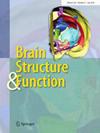一千种方法来定制你的基于神经束图的连接体。
IF 2.9
3区 医学
Q1 ANATOMY & MORPHOLOGY
引用次数: 0
摘要
你知道有成千上万种方法可以通过扩散核磁共振束状图建立连接体,而方法的选择可以极大地影响最终的连接体和结果吗?仅举几个例子:示踪类型:确定性还是概率性?分割分辨率:粗图集还是细图集?边缘加权:流线计数、长度或微观结构特性?这些选择产生了一个令人生畏的岔路花园。在本文中,我们将修改您在计划构建基于图的连接体时必须做出的基本决策,以及它们对其网络分析的影响。本文章由计算机程序翻译,如有差异,请以英文原文为准。
A thousand ways to tailor your tractography-based connectome.
Did you know that there are thousands of ways to build a connectome from diffusion MRI tractography, and the choice of approach can hugely impact the final connectome and results? To name only a few: Tractography type: deterministic or probabilistic? Parcellation resolution: coarse or fine atlas? Edge weighting: streamline count, length, or microstructural properties? These choices give rise to a daunting garden of forking paths. In this article, we revise fundamental decisions you must make when planning to build a tractography-based connectome and their impact on its network analysis.
求助全文
通过发布文献求助,成功后即可免费获取论文全文。
去求助
来源期刊

Brain Structure & Function
医学-解剖学与形态学
CiteScore
6.00
自引率
6.50%
发文量
168
审稿时长
8 months
期刊介绍:
Brain Structure & Function publishes research that provides insight into brain structure−function relationships. Studies published here integrate data spanning from molecular, cellular, developmental, and systems architecture to the neuroanatomy of behavior and cognitive functions. Manuscripts with focus on the spinal cord or the peripheral nervous system are not accepted for publication. Manuscripts with focus on diseases, animal models of diseases, or disease-related mechanisms are only considered for publication, if the findings provide novel insight into the organization and mechanisms of normal brain structure and function.
 求助内容:
求助内容: 应助结果提醒方式:
应助结果提醒方式:


